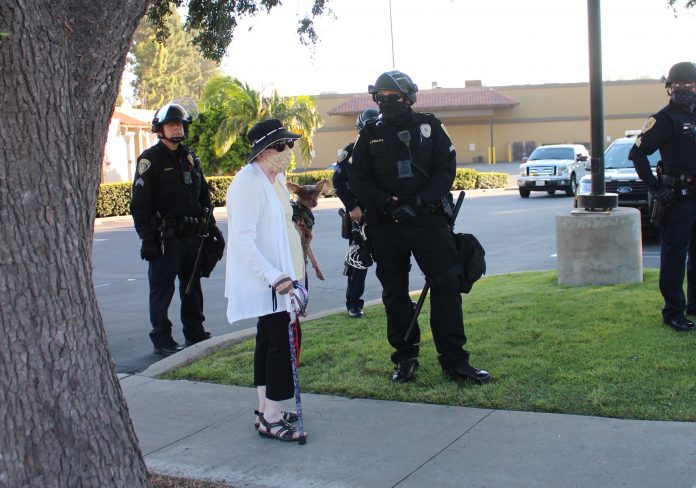
As the nation passes 90 days of Black civil rights protests, adults who lived through the Civil Rights movement of the 1950s and ‘60s comment on the current, sometimes destructive and violent protest movement happening locally.
“I remember very well growing up and being in college in the Vietnam War, moving from a fairly conservative family to more and more leftward positions as I thought about things over time. I also remember being very influenced by the Civil Rights movement and admiring the non-violent protests,” Larry Brunton said.
Brunton, 73, recently attended an Aug. 21 class held at La Mesa’s Oasis learning center for adults 50 and older on the topic of Dr. Martin Luther King, Jr.’s ‘Letter from Birmingham Jail’ led by Southwestern College Professor of Philosophy and Humanities Peter Bolland. The event was part of a series on racism, history, police reform, and criminal and social justice.
Brunton said Bolland’s class on King’s letter was thought-provoking and that he used to read part of the Letter from Birmingham Jail to his students at University of California San Diego each year before King’s birthday, followed by instructions to go home and read the letter in its entirety.
He said he has marched in protests moderately and regularly over past decades and, although he has distanced himself at home in recent months, he remains concerned about the environment and politics.
“I think we have to get out there and stand up and shake our fists when we see things that aren’t right… If there is some violence, we have to accept that that’s how angry people are. The Civil Rights movement had some success but clearly not enough,” Brunton said.
Brunton said recently deceased civil rights leader and Congressman John Lewis left a wealth of inspiration for young protesters in the form of his graphic memoirs, March.
“They point out how effective nonviolence can be, how effective persistence and preparation can be. When John Lewis, when King wanted to demonstrate they didn’t just run out, they planned the demonstration and pictured what could happen, practiced responding nonviolently and practiced being arrested, in fact they hoped to be arrested. The lesson from the Civil Rights movement is how to conduct a demonstration,” Brunton said.
It is a thought echoed by Bolland.
“What’s so inspiring about King and Lewis is how they understood the only way forward is to have the difficult, awkward conversations with people who disagree and find common ground,” Bolland said.
He contrasts peaceful demonstrations organized by King with more aggressive ones recently held in La Mesa.
“Everybody wants justice. Everybody wants peace. Everybody wants neighborhoods where businesses can thrive—that’s not a liberal or conservative issue. In reaching out and trying to cultivate more allies for social justice change, you don’t start with ‘F- – k the police, you start with respect… It doesn’t come top down from the legislature, it comes from the community,” Bolland said.
Maggie Ikezaki also attended Bolland’s class. She prefaced her comments on protests and racism by saying she is Asian and believes Asians tend to take a step back from anything as vocal as a protest.
“I’ve always been supportive of the protesters, knowing there is institutional racism. I live in Mission Valley, amongst young people and I’m thrilled with Millennials and Generation Z, that they’re taking a stand and maybe in their time they will get into leadership positions and really make change,” Ikezaki said.
Referring to students from Marjory Stoneman Douglas High School in Florida who made a 2018 national appeal against gun violence and school shootings, Ikezaki said she was struck by how a group of high schoolers gained attention almost overnight simply by being vocal.
“They were high schoolers standing up to national news media, going out and getting young people signed up to vote. That’s what I would encourage young people to do. They’re at the point where they’re almost larger than the Baby Boomers and can change things. I don’t know how many understand you have to sit in on the city council meetings and get involved locally; you have to vote,” Ikezaki said.
Ikezaki is concerned about counterprotest groups she says appear to believe in only one manifesto.
“They tend to use labels like patriotism and a ‘true American’ and that part is very scary because it makes it very easy to recruit,” Ikezaki said.
“What’s happening now with Black Lives Matters includes not just Blacks but also other minority groups. People my age, in their late ‘70s, we’ve seen a lot. King, Gandhi, even Thoreau writing about Civil Disobedience back in the 1840’s, they all preached nonviolence. Unfortunately, when you hold peaceful protests you always have people turn up to disrupt, to vandalize but it’s important not to throw the baby out with the bathwater. Don’t discount the protest because of a few bricks,” said 78-year-old Tom Lohner.













